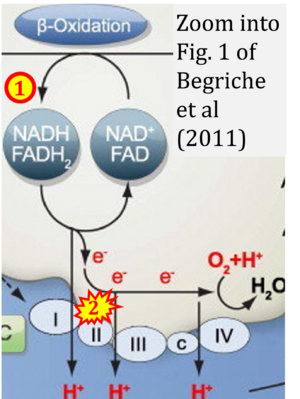Begriche 2011 J Hepatol
| Begriche K, Massart J, Robin MA, Borgne-Sanchez A, Fromenty B (2011) Drug-induced toxicity on mitochondria and lipid metabolism: mechanistic diversity and deleterious consequences for the liver. J Hepatol 54:773-94. https://doi.org/10.1016/j.jhep.2010.11.006 |
Begriche K, Massart J, Robin MA, Borgne-Sanchez A, Fromenty B (2011) J Hepatol
Abstract: Numerous investigations have shown that mitochondrial dysfunction is a major mechanism of drug-induced liver injury, which involves the parent drug or a reactive metabolite generated through cytochromes P450. Depending of their nature and their severity, the mitochondrial alterations are able to induce mild to fulminant hepatic cytolysis and steatosis (lipid accumulation), which can have different clinical and pathological features. Microvesicular steatosis, a potentially severe liver lesion usually associated with liver failure and profound hypoglycemia, is due to a major inhibition of mitochondrial fatty acid oxidation (FAO). Macrovacuolar steatosis, a relatively benign liver lesion in the short term, can be induced not only by a moderate reduction of mitochondrial FAO but also by an increased hepatic de novo lipid synthesis and a decreased secretion of VLDL-associated triglycerides. Moreover, recent investigations suggest that some drugs could favor lipid deposition in the liver through primary alterations of white adipose tissue (WAT) homeostasis. If the treatment is not interrupted, steatosis can evolve toward steatohepatitis, which is characterized not only by lipid accumulation but also by necroinflammation and fibrosis. Although the mechanisms involved in this aggravation are not fully characterized, it appears that overproduction of reactive oxygen species by the damaged mitochondria could play a salient role. Numerous factors could favor drug-induced mitochondrial and metabolic toxicity, such as the structure of the parent molecule, genetic predispositions (in particular those involving mitochondrial enzymes), alcohol intoxication, hepatitis virus C infection, and obesity. In obese and diabetic patients, some drugs may induce acute liver injury more frequently while others may worsen the pre-existent steatosis (or steatohepatitis).
• Bioblast editor: Gnaiger E
Correction: FADH2 and Complex II
- FADH2 is shown as the substrate feeding electrons into Complex II (CII). This is wrong and requires correction - for details see Gnaiger (2024).
- Gnaiger E (2024) Complex II ambiguities ― FADH2 in the electron transfer system. J Biol Chem 300:105470. https://doi.org/10.1016/j.jbc.2023.105470 - »Bioblast link«
Labels:
Enzyme: Complex II;succinate dehydrogenase
Pathway: F


